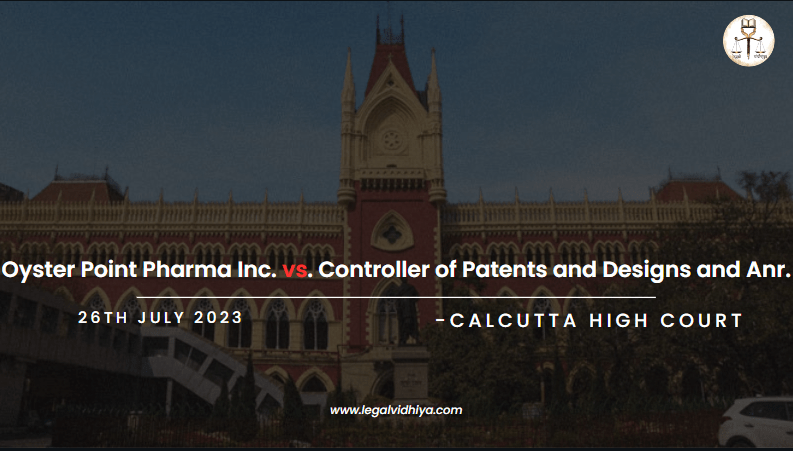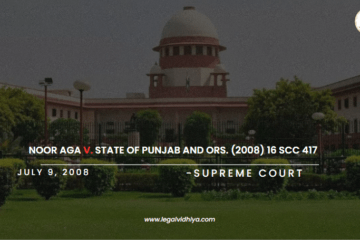
| CITATION | 2023 SCC OnLine Cal 2141 |
| DATE OF JUDGMENT | 26th July 2023 |
| COURT | High Court of Calcutta |
| APPELLANT | Oyster Point Pharma Inc. |
| RESPONDENT | Controller of Patents and Designs and Another |
| BENCH | Ravi Krishna Kapur, J. |
INTRODUCTION
In the case of Oyster Point Pharma Inc. vs. Controller of Patents and Designs and another, an appeal was filed by the appellant under Section 117A of The Patents Act,1970 against the order passed by the Assistant Controller of Patents and Designs. The order by the respondent rejected Patent Application No. 1879/KOLNP/2011 dated 5 May 2011 filed by the appellant. The appeal was made on 16th September 2021. The grounds for rejecting the patent application were under sections 2(1)(ja) and 3(d) of the Act. By this appeal, the appellant requested permission for further trials to prove the efficacy of the invention.
FACTS OF THE CASE
- The appellants are a biopharmaceutical company to treats ocular surface diseases and indulges in the discovery, development, and commercialization of first-in-class pharmaceutical therapies.
- In furtherance of their correspondence the company invented stereospecific synthesis of (R)-5(E)-2- pyrrolidin-3-ylvinyl)pyrimidine, its salt forms, and novel polymorphic forms of these salts. This new invention aims at treating medical conditions such as pain, inflammation, and conditions associated with dysfunction of the central and autonomic nervous systems.
- The appellant submitted before the respondent an application with claims from 1-35 and form 13 on 31 October 2017 and making voluntary claims to 1-9 on 22 October 2018.
- In furtherance of the application on 10 July 2019 a First Exam Report was issued. In consequence of this, a precise reply to the FER and a revised set of claims was submitted by the appellants on 11 February 2020.
- Subsequently a hearing notice was issued on 6 July 2020. Thereafter, a detailed written statement and further revised claims 1-5 were submitted by the appellant on 11 September 2020.
- The application for a patent by the appellant was rejected by the respondent on the grounds of Section 2(1)(ja) and Section 3(d) of The Patents Act 1970. The respondents cited three prior art documents i.e., D1, D2 and D3 for rejecting the application.
- The Controller denied issuing the Second Exam Report (SER).
ISSUES RAISED
- The central issue was whether the rejection of the patent application under Section 2(1)(ja) and 3(d) was legally correct
- Whether the present invention of the appellant demonstrate the required “therapeutic efficacy”?
CONTENTIONS OF APPEALLANT
- The learned counsel for the appellant contended before the Hon’ble High Court that though prior art D1 describes various compounds including galactarate salt of (R)-5-((E)-2-pyrroliding-3-ylvinyl)pyrimidine the mere mentioning of the compound in the prior art does not render the advantageous properties of the claimed invention by the appellants.
- The appellants urged to commercialize the compound which in its free base form is a viscous oil with limited water solubility and stability, a means of dealing with these limitations and also ease the manufacturing process was to be formulated.
- Furthermore, to prove that the appellants conducted skilled additional experiments on the product the learned advocate contended that the mono-citrate salt could be obtained in stable, free-flowing solid forms both amorphous and crystalline, not sensitive to moisture or temperature, nor is it hygroscopic and the same does not deliquesce upon stability testing, the same as mentioned in the PCT specification the respondents failed to understand.
- The learned advocates emphasized on the fact that no pharmaceutically acceptable salt can be obtained from mere addition of D2 and D3 acids and that no discussion about whether the appellant lacked inventive steps.
- The counsel for the appellant brought to the notice of the court that the amended set of claims 1-5 and Appendix C mention enhanced efficacy of the claimed invention which the respondent did not consider along with any additional experimental data.
- The counsel quoted the case of Novartis AG vs Union of India (2013)6 SCC 1 where to prove the efficacy of a drug the findings of additional experimental data was permitted.
CONTENTIONS OF REPONDENT
- The counsel for the respondent contended that the claimed invention lacks any specific enhanced efficacy and is a different form of mono-citrate salts of the compound (R)-5-((E)-2-pyrroliding-3-ylvinyl) pyrimidine.
- The respondents contended that Appendix A, B, and C were not taken into consideration while passing the impugned order due to the untimely submission.
- The claimed invention was alleged by the respondent to be a “new form of a known substance” which cannot be patented unless shows a significant difference in efficacy.
- The learned advocates urged that issuing of Second Examination Report wouldn’t have made any significant change.
JUDGEMENT
The High Court of Calcutta in its judgement held that the order is unsustainable and is to be set aside. The court after hearing both sides concluded that the PCT specifications are proof enough that the commercialisation of the compound due to its nature in base state required diligent experimental work. Hon’ble Judge in light of the case of Agriboard International LLC vs Deputy Controller of Patents, C.A. (CoMM.IPD-PAT observed that it is to be analysed by the Controller whether the prior knowledge directly suggests or indicates the claimed invention which the documents failed to prove.
The second issue regarding the efficacy of the compound as mentioned in Section 3(d) of the Patents Act, 1970 was judged by the court by addressing Novartis A.G. vs. Union of India. The court observed that the enhanced efficacy of the substance could not be determined without considering the reports of precise additional experiments. The court held that the respondent’s reasoning for the belated submission of Appendix A, B, and C can’t be taken into consideration. The Controller did not assign any reason to reject Appendix C which emphasizes the enhanced efficacy and for not taking into consideration Appendix A which mentions the stability of the salt. The court ordered the respondent authorities to adjudicate the patent application.
ANALYSIS
The Controller while considering the patent application should keep in mind that drug development is a very time-consuming process that might need alteration and addition in process and providing full entire data on the onset itself is not possible. The Controller should thus entertain a little delayed submissions if it proves the enhanced efficacy of the newly invented compound. Section 3(d) of the Patents Act, of 1970 talks about the necessity of the efficacy of the newly invented compound but does not mention the degree which it has to achieve to be considered a new invention which shows as a gray area of the law.
The contention that the Second Examination Report (SER) would have been immaterial is baseless and that the statutory mandate of Section 13(3) must be followed regardless of the consequences. The controller while addressing the patent application tests to determine whether the said invention involves required inventive steps as observed in the case of Agriboard International LLC vs Deputy Controller of Patents, C.A. The decision taken by the controller regarding permitting any patent application should not be arbitrary and should hold reasonable judicial reasoning behind it.
CONCLUSION
In Oyster Point Pharma Inc. vs. Controller of Patents and Designs, the High Court of Calcutta set aside the rejection of a patent application, emphasizing the importance of diligent experimental work in pharmaceutical inventions. The rejection of the patent application was centered around the alleged lack of therapeutic efficacy of the claimed invention.
In conclusion, the judgment of the high court directs the respondent authorities to evaluate the patent application, emphasizing the importance of thorough examination consideration of experimental data and other ends to the statutory mandate. The case serves as a reminder of the nuanced nature of patent issues and the need for a balanced approach in determining the patentability of inventions.
REFERENCES
- SCC Online
- https://indiankanoon.org/doc/104264429/
This Article is written by Ananya Sarita Tripathi student at the University of Lucknow and an intern at Legal Vidhiya.
Disclaimer: The materials provided herein are intended solely for informational purposes. Accessing or using the site or the materials does not establish an attorney-client relationship. The information presented on this site is not to be construed as legal or professional advice, and it should not be relied upon for such purposes or used as a substitute for advice from a licensed attorney in your state. Additionally, the viewpoint presented by the author is of a personal nature.




0 Comments